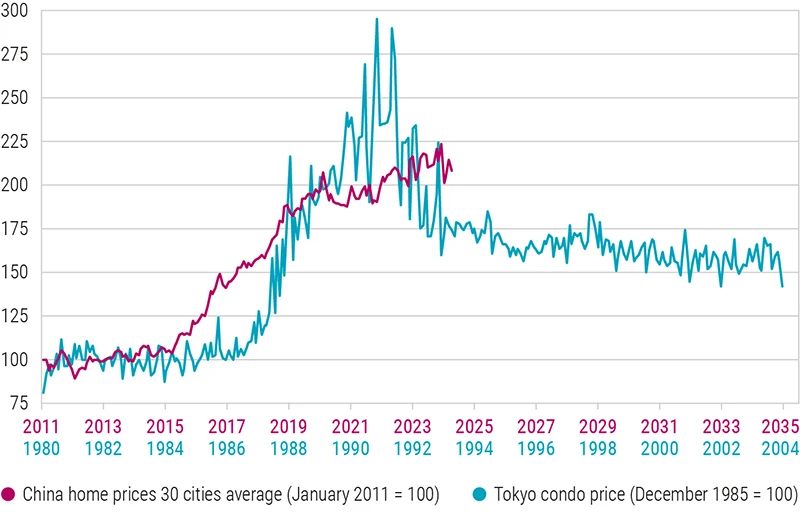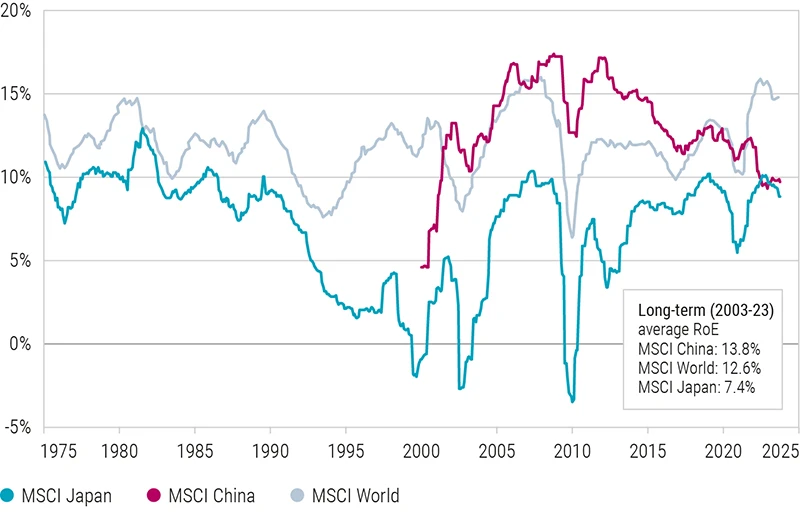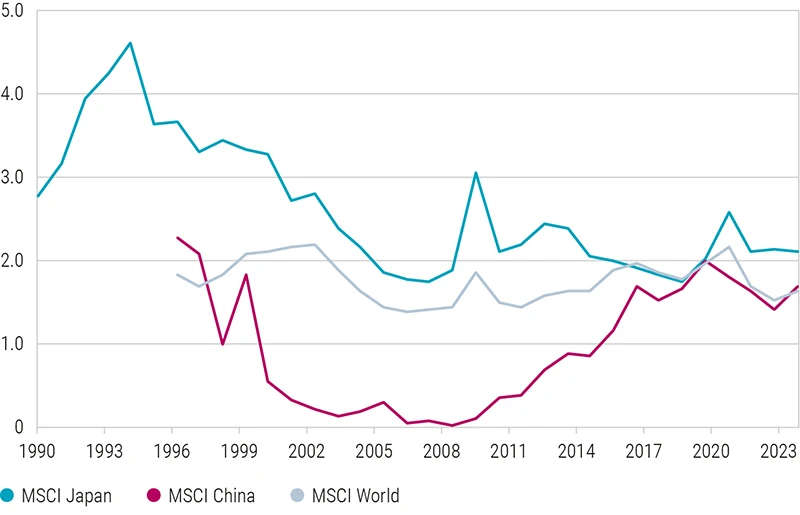Japan’s economy in the late 1980s was characterized by rapid growth and high levels of investment and the country reached a weight of 40% in the MSCI World Index before the bubble burst. It then took the Nikkei 225 nearly 35 years to surpass its December 1989 high. The bursting of the asset price bubble brought about economic stagnation and deflation. Land prices bottomed out only in 2005 and the Japanese stock market didn’t even hit rock bottom until 2012.
Is history repeating itself in China now? Some parallels are becoming increasingly apparent. In 2017, China was projected to become nearly 50% of the global emerging markets benchmark as more and more of the vibrant A-share market became accessible to foreign investors. The market lost its mojo though after the government clamped down on the all too powerful position of the internet giants. China now has ‘just’ a 24% weight in the MSCI Emerging Markets Index.
Can China regain its momentum or will it go the way of Japan with a lost generation for the economy and investors? Are we now seeing a Japanification of China?
Property market woes are not comparable
In 1980s Japan, companies used property and land to lever up and buy more commercial property or expand into other economically unviable projects. When the bubble collapsed, the corporates and the banks carried the weight of the downturn. In contrast the problems In China are in residential property, not in commercial. Many Chinese families own several properties as an investment or retirement nest egg, hoping for capital gains.
China was already aware of the risks of this activity and acted to avoid a bubble developing. Hence, prices never went up as much as during the land speculation frenzy in Japan in the 1980s. Average residential sales prices per square meter rose 7.3% annually since 2007, well below the increase in annual nominal GDP of about 12% over that same period. In Tokyo, home prices grew 13% annually, well above nominal GDP growth of about 8% in the 1980s.
Figure 1: China home prices: Never really bubbly

Source: CEIC, National Bureau of Statistics, Nomura Research Institute.
Demographics, debt, and deflation
Japan’s population peaked twenty years after the bubble burst in 2010 at 128 million and stood at 123 million in 2023. In comparison, China’s population peaked in 2021 at 1.42 billion and has shrunk slowly since then. The demographic challenge could keep the housing market subdued, as demand is likely to recede. Subsequent deflation increases the real value of debt, necessitating policy to create inflation to keep this manageable. If there ever was a time for easy monetary policy in China, it is now. Japan is generally seen as having erred in keeping monetary policy tight for too long during the early 1990s.
China has a better starting position to deal with leverage and excess capacity than Japan had, since it has more of a growth runway ahead than Japan did in the 1990s. According to IMF data, per capita income in Japan at the end of its economic miracle was 120% that of the US, while in China it stands at 16% now. Economic growth at about 5%, driven by productivity gains, means China can grow out of its problems more easily. A caveat here would be that policy-making in China is deemed to have become less pragmatic and more dogmatic which may result in suboptimal decisions.
CNY is not undervalued
US politicians claim the yuan is cheap today, but real effective exchange rate calculations show it is actually a little expensive. Even at today’s rate, the country is super-competitive and generates a trade surplus of about USD 1 trillion annually. China will not have to fight imported deflation from a rising currency. Its interest will be best served by currency stability and the yuan is unlikely to move a lot over the next five years.
ROE and equities
For long-term equity investors, return on equity (RoE) is a crucial yardstick. Considering Chinese companies’ balance sheets probably won’t be affected by the fall in property prices, they are not expected to deleverage like Japan’s corporate sector did in the 1990s. There is a risk though that many industrial companies have overinvested and will need to deal with lower margins and potential write-downs of obsolete factories in the next five years. This could cause Chinese RoE to fall, causing lackluster equity market performance. However, the gearing of Chinese corporates is average by international standards and balance sheets do not need repair via equity issuance. Many private companies have announced buybacks in response to the weakness in share prices: clear capitalist behavior that equity investors will appreciate.
Figure 2: Better RoEs in China than in Japan

Source: MSCI, Morgan Stanley research.
Stay informed on our latest insights with monthly mail updates
Receive our Robeco newsletter and be the first to read the latest insights and build the greenest portfolio.
Figure 3: China vs Japan net debt/EBITDA (ex-financials)

Source: MSCI, Morgan Stanley research.
Conclusion
There are three main reasons to assume China will not face the ordeal that Japan lived through. First, Chinese policy makers have been able to contain property price increases to a more manageable level. There is far less leverage in the China property market than there was in Japan.
Second, China can still grow its way out of the problem as there is plenty of room for productivity gains. Third, Chinese corporates so far seem to better understand the cost of equity and also have not been shell-shocked into a rapid de-leveraging cycle.
Chinese companies must now demonstrate they can sustain RoE in the face of overcapacity. If they can, the equity market is undervalued. Conversely, Japanese RoE is on a decisive uptrend, and if they can reach the old Chinese levels, the equity market outlook for Japan will also be bright.
This article is an excerpt of a special topic in our five-year outlook.
Webinar: 5-Year Expected Returns 2025-2029
Our five-year outlook on market opportunities and risks.
